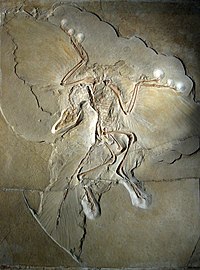
Photo from wikipedia
Pennaceous feathers capable of forming aerodynamic surfaces are characteristic of Pennaraptora, the group comprising birds and their closest relatives among non-avian dinosaurs. However, members of the basal pennaraptoran lineage Oviraptorosauria… Click to show full abstract
Pennaceous feathers capable of forming aerodynamic surfaces are characteristic of Pennaraptora, the group comprising birds and their closest relatives among non-avian dinosaurs. However, members of the basal pennaraptoran lineage Oviraptorosauria were clearly flightless, and the function of pennaceous feathers on the forelimb in oviraptorosaurs is still uncertain. In the basal oviraptorosaur Caudipteryx both the skeleton and the plumage, which includes pennaceous feathers forming wing-like arrangements on the forelimbs, are well known. We used mathematical analyses, computer simulations and experiments on a robot Caudipteryx with realistic wing proportions to test whether the wings of Caudipteryx could have generated aerodynamic forces useful in rapid terrestrial locomotion. These various approaches show that, if both wings were held in a fixed and laterally extended position, they would have produced only small amounts of lift and drag. A partial simulation of flapping while running showed similarly limited aerodynamic force production. These results are consistent with the possibility that pennaceous feathers first evolved for a non-locomotor function such as display, but the effects of flapping and the possible contribution of the wings during manoeuvres such as braking and turning remain to be more fully investigated.
Journal Title: Scientific Reports
Year Published: 2018
Link to full text (if available)
Share on Social Media: Sign Up to like & get
recommendations!